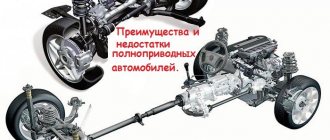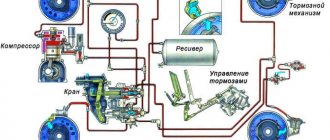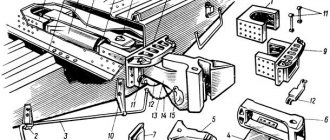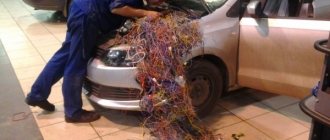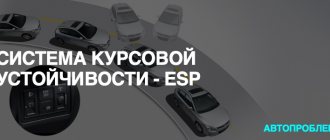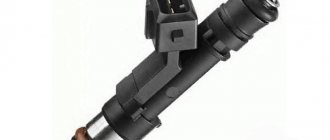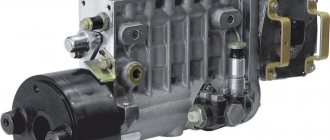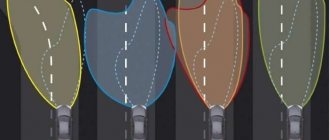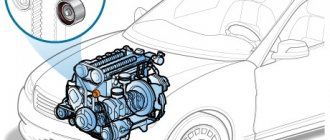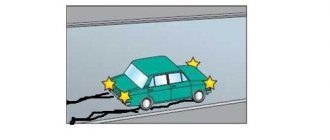About the Wheelbarrow ⁄ Useful articles ⁄
Modern cars are equipped with truly modern all-wheel drive systems. Each manufacturer, each car brand gives preference to a certain type of system. For example, Volkswagen is a fan of 4motion all-wheel drive, while Audi is attracted to quattro. Needless to say that the systems that we will consider are developments for specific car brands? We will find out what all-wheel drive systems are in this article.
4Motion all-wheel drive system
Briefly, we have already said that this system is installed on Volkswagen cars. A special feature of 4Motion all-wheel drive is the automatic connection of a second axle if the road situation requires it. The electronics are configured in such a way that as soon as the main drive wheels begin to slip, an additional drive is connected as auxiliary ones.
We will not interfere with the technical component of this system, since it is quite complex. In general terms, it can be noted that absolutely everything is controlled by electronics. The all-wheel drive unit is connected to the ABS system, and based on the data provided by the ABS sensors, the control unit makes a decision about connecting the second axle and distributing torque between them. Of course, all this is possible thanks to preset action algorithms, i.e. The system simulates situations, and it selects the necessary algorithm of actions, depending on certain conditions.
Disable immobilizer
4Motion all-wheel drive system
The 4Motion all-wheel drive system refers to the so-called. all-wheel drive systems connected automatically. In this system, engine torque is distributed among the axles depending on the driving situation. The 4Motion system has been installed on Volkswagen vehicles since 1998. The name 4Motion is a registered trademark.
The 4Motion all-wheel drive system includes a front axle differential in the transmission, transfer case, rear axle driveline, multi-plate clutch, final drive and rear axle differential.
The front axle differential transmits torque from the gearbox to the front drive wheels. The front axle differential housing is connected to the transfer case by a hollow shaft.
The transfer case is a bevel gear through which torque is transmitted at an angle of 90 degrees. The rear axle drive shaft drive connects the transfer case and the friction clutch.
The cardan transmission consists of two shafts connected by a constant velocity joint. The shafts are connected to the transfer case and the friction clutch using elastic couplings. The rear propeller shaft has an intermediate support.
The 4Motion all-wheel drive system uses a Haldex multi-plate friction clutch. The clutch provides controlled transmission of torque (the amount of transmitted torque is determined by the degree of closure of the clutch) from the front to rear axle of the vehicle. The Haldex clutch is integrated into the differential housing of the rear axle.
Currently, the 4Motion all-wheel drive system uses the fourth generation Haldex clutch (Volkswagen Tiguan cars), which has a simpler design compared to its predecessors. Before this, clutches of the first and second generations were installed (Volkswagen Golf IV, V cars - optional, Volkswagen Transporter).
Structurally, the Haldex clutch includes a pack of friction discs, a pump, a pressure accumulator and a control system.
The friction disc package is a set of friction and steel discs. The friction discs have internal engagement with the hub. Steel discs have external engagement with the drum. The number of disks determines the amount of transmitted torque (more disks - more torque). The discs are compressed by pistons.
The Haldex coupling has electronic control, including input sensors, a control unit and actuators. The input sensor of the control system is the oil temperature sensor.
The control unit converts incoming information into control actions on the actuator. In addition to the oil temperature sensor, the electronic control unit uses information from the engine control unit, the ABS system control unit, received via the CAN bus.
The actuator of the control system is a control valve that regulates the compression pressure of the friction discs from 0 to 100% of the maximum value. The amount of pressure is determined by the position of the valve.
The pump and pressure accumulator ensure that the oil pressure in the system is maintained at 3 MPa.
☑ Operating principle of the system
The operation of the 4Motion system is determined by the operation algorithm of the Haldex coupling, in which the following characteristic modes can be distinguished:
• start of movement; • start of movement with slipping; • movement at constant speed; • movement with slipping; • braking.
When starting and accelerating the vehicle, the control valve is closed and the clutch discs are compressed as much as possible. Maximum torque is transmitted to the rear wheels.
If movement begins with both front wheels slipping, the control valve closes and the clutch friction discs are compressed. The torque is completely transmitted to the rear axle. When one of the front wheels slips, the system first engages the electronic differential lock.
When driving at a constant speed, the valve opens and the discs compress depending on the driving conditions. Torque is transmitted to the rear axle within certain (insignificant) limits.
Slipping while the vehicle is moving is determined based on signals from the ABS system control unit. In this case, the valve opens depending on the driving conditions (which axle and which wheels are slipping).
When braking, the control valve is open, the clutch friction discs are completely released. No torque is transmitted to the rear axle.
Share the news with friends:
Similar
Quattro all-wheel drive system
The main feature of quattro all-wheel drive is not plug-in, but permanent all-wheel drive, i.e. The car has a 4x4 drive in any driving conditions. The peculiarity of this drive, just like the peculiarity of Audi cars on which this system is installed, is the transverse location of the engine, transmission of torque using a cardan drive. It is also noteworthy that the cars are equipped with two driveshafts.
Speaking of the all-wheel drive system, quattros are equipped with a low gear, which is integrated directly into the gearbox. The center differential has an electronic lock. This drive system ensures reliable movement in all conditions, even on difficult road sections.
4Matic all-wheel drive system
This all-wheel drive system is installed on SUVs and some passenger cars from Mercedes Benz. The main feature is the mandatory presence of an automatic transmission, the presence of two driveshafts, one of which transmits torque to the front axle, the other to the rear axle. The highlight of the system is the continuously variable transmission of forces on the vehicle’s axles, which ensures the highest possible dynamics, as well as comfortable driving conditions.
In such a case, the problem of this all-wheel drive system would be with the stability of the car, but the company found a way out by equipping the car with electronic driving assistants. However, 4matic is intended only for driving the car on asphalt roads; it will be of no use off-road. However, if we take into account that these are Mercedes cars, and rarely does anyone want to knead dirt on them, then the disadvantage is not taken into account at all.
Which version of Volkswagen Tiguan to buy
Of course, first of all, it all depends on your wallet size and personal preferences. First, before purchasing, decide whether the power of the car is important to you and whether you need all-wheel drive, which will not help you even on light off-road conditions. If the main thing for you is fuel consumption, then feel free to buy the 122-horsepower version in the basic configuration, which will delight you with its acceptable efficiency. But don't expect any amazing fuel economy from this modification.
If power is important to you, but you don’t have the funds to buy the R-Line modification, then buy the 170-horsepower version of the crossover with a 2.0-liter turbo engine. But keep in mind that, despite not very much power, be prepared to spend a lot of money on gasoline.
xDrive all-wheel drive system
Another German auto giant called BMW could not stand aside. The company equips some of its vehicles with its own all-wheel drive system called xDrive. The main characteristic is the presence of permanent all-wheel drive, as well as variable, stepless torque distribution between the axles of the car.
As is the case with the 4motion system, this all-wheel drive is equipped with a control unit, which is also pre-installed with various action algorithms that are used depending on the situation. The system automatically distributes traction forces between the axles, thus ensuring reliable traction.
What's new in the 2020 Volkswagen Tiguan?
The Tiguan crossover has been in production since 2007. In 2011, the car received a restyling. In 2014, the German brand added a sports line of crossovers “R-Line”. In 2020, Volkswagen completely updated the crossover, releasing the second generation Tiguan. The debut of the car is scheduled for September 15, 2015 at the Frankfurt Motor Show.
From the very beginning, the car was produced with both front-wheel drive and all-wheel drive. The car is equipped with 1.4 TSI petrol engines with a power of 122 and 150 hp. , turbocharged 2.0 TSI with 170 and 200 hp. and a 2.0 TDI diesel engine with 140 hp. Power units are paired with a 6-speed manual transmission or 6-speed automatic transmission.
It is worth noting that the new Tiguan R-Line series, which was introduced in 2014, is equipped with an automatic seven-speed dual-clutch transmission 7-DSG 4Motion.
It is noteworthy that from 2020, Volkswagen intends to equip the new generation of cars with automatic transmissions only on the new Tiguan model (for some car markets, the German brand will continue to supply crossovers with a six-speed manual transmission).
Which system is more promising?
We looked at the main all-wheel drive systems of German-made cars. You may probably think that since the systems are fully automated, they are free of all sorts of disadvantages. On the contrary, a large number of sensors and fully electronic control are another reason for a malfunction to occur. To this we can add the fact that the electronics and the programs preinstalled in them will not be able to fully realize themselves in road conditions. In this regard, the Quattro system, which is installed on Audi cars, seems to be the most advanced. Thanks to the presence of a low gear, which is integrated directly into the gearbox, on the one hand, reliable movement is ensured, on the other hand, easier maintenance, when compared with other representatives of 4x4 systems we have reviewed.
Review of the Volkswagen Tiguan | For those who want to buy a Volkswagen Tiguan.
The Volkswagen Tiguan is a compact car with high ground clearance. This car is needed for those who appreciate German quality and for those who want to forget that they are driving a crossover. What do you need to know before you buy a Volkswagen Tiguan? Don't worry, we'll tell you everything you want to know about this car in our new "What You Need to Know Before Buying a Car" series.
Volkswagen is believed to be selling the Tiguan as a top-of-the-range version of the VW Golf GTI. But, despite some obvious similarities in equipment (including the presence of a 2.0 liter four-cylinder turbocharged engine, which is installed on the charged Golf GTI), this is not the case. In terms of positioning, these are two completely different cars, although the Tiguan is based on the Golf platform.
For example, those who buy a Volkswagen Golf GTI are most often young people who want a drive on weekends after hard working days at universities, institutes, etc.
If you don't want a low compact Golf, don't want to buy a Ford or any other non-German car, and can't afford a Lexus, then you should consider the Tiguan crossover.
Another comparison example between the Volkswagen Tiguan and the Golf GTI. We all know that the GTI is one of the best in its class. Tiguan no. Yes, undoubtedly, this crossover is a high-quality and comfortable car with all-wheel drive, but it is not as fast, it is more expensive, and it is not as efficient as the legendary VW Golf GTI.
People buy crossovers and SUVs, just like compact A and B class cars, guided by the same wishes, preferences, etc.
Those who want to buy a crossover think about reliability, safety and fuel economy. Most compact car buyers are thinking the same thing. Unfortunately, compared to compact passenger cars, the Tiguan lags significantly behind in terms of efficiency.
For example, the Track&Field version, which is equipped with a 2.0 TSI 125 engine with 170 hp. and a 6-speed automatic transmission, the 4Motion automatic consumes 13.5 liters per 100 km in the city, 7.7 l/100 km on the highway, and 9.9 l/100 km in the combined cycle.
Agree, such values for a compact crossover, which is based on the VW Golf and has a 2.0 liter power unit, are too unmodern. Taking into account modern standards of efficiency, if you buy this car, you will pay significantly more at each gas station compared to the owners of competing crossovers. Even the 1.4 liter 122-horsepower version of the Tiguan does not have amazing fuel consumption (city 8.3, highway 5.5, combined cycle 6.5).
Therefore, some Tiguan owners often joke that there is a carburetor under the hood of their car.
